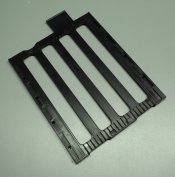I need help troubleshooting/salvaging a stained negative.
In the attached negative scan, you should be able to see some brownish/yellowish stains. In the scan, color saturation has been boosted for clarity reasons. The hue is quite true to how the negative looks like.
/Henrik


In the attached negative scan, you should be able to see some brownish/yellowish stains. In the scan, color saturation has been boosted for clarity reasons. The hue is quite true to how the negative looks like.
- The stains appear to be on the *base side* of the negative, *not* on the emulsion side.
- I used a SP-445 tank to process the negative.
- If I recall correctly, the current sheet was processed in a batch in which two sheet somehow stuck to the one sitting on the other side of the film holder (see attached image, the holder takes one sheet on each side with emulsion facing outwards); back-to-back and with the film holder sandwiched in between. After processing, I gently had to separate the sheets in order to unload them from the holder. This of course should explain the regular geometry of the stains. However, I do not recall noticing any marks/stains immediately after the processing and while hanging the negs to dry. The other sheet show similar stains.
- oxidized developer ?
- fixer remains ?
- any other explanation that I have not thought about?
/Henrik






